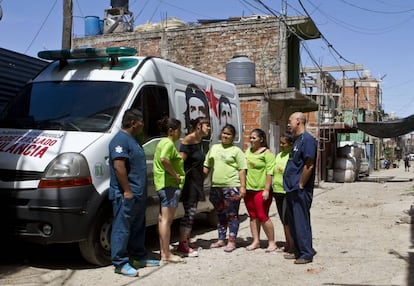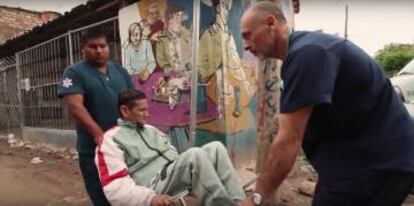How shanty town ambulances are saving lives in Argentina
Activists in Buenos Aires have set up emergency services that work in the capital’s slums

Octavio can’t move. A degenerative illness has left him immobile in a wheelchair in the heart of the Villa 1-11-14 neighborhood, one of the largest shanty towns in Buenos Aires. The district is Octavio’s worst enemy: not just because it is unsafe, but also because the ambulances that are supposed to take him to hospital for treatment refuse to enter its narrow streets.

Ambulance staff say they have been attacked and don’t feel safe in the area. But for the last two years there has been an alternative: the Villeras emergency services center. This organization operates five ambulances emblazoned with the faces of Che Guevara and the priest Carlos Mugica – assassinated in 1974 for fighting for the rights of the poor – in 20 slums in the Argentinean capital where the state won’t go.
The hotline provides access to a network that includes health centers and toxicology units
Two years ago members of the left-wing movement Corriente Villera Independiente decided they were tired of waiting for health services to arrive in the area and set up a hotline to attend to emergency service calls coming from 1-11-14. Most of the ambulance services are pre-programed as is the case with Octavio, but they also provide emergency services.
Sometimes, it is a question of life or death. The drivers and nurses live in the neighborhood and know every inch of the labyrinth of streets where they work.
“The problem [before] was that to call an ambulance you had to contact the police. This means delays, and neighbors died in cases where it could have been avoided, like a simple attack of epilepsy,” says Marina Joski, the center coordinator.

“Another problem is that our houses have two of three stories and spiral staircases. Patients who are morbidly obese, for example, and have to go to hospital for a checkup have to stay at home because ambulances don’t want to bring them downstairs.
This is where the fire brigade comes in. Formed of young people in the neighborhood, the firefighters help ambulances with “difficult” cases. And they also put out fires.
“At first we went around the area with a fire extinguisher in each hand, while we handed out flyers with our telephone number so that people found out about us,” says Humberto Quispe. Seven months ago, the brigade managed to buy a small, secondhand fire engine, well equipped and perfect for the neighborhood’s narrow streets.
Ambulance staff say they have been attacked and don’t feel safe in the area
“We get there first because we know the streets. We provide initial assistance and then leave it to the fire brigade and the police,” says 19-year-old Augusto. Standing next to him is Harold, who says the main problem is short circuits resulting from the improvised electrical wiring in 1-11-14 – especially in winter when residents turn on their electrical heating.
The hotline center has a gym so staff and emergency services personnel can keep in shape: all financed without government or private funding. The staff work as part of a cooperative and receive the same salary.
Joski explains that the hotline doesn’t just provide ambulances and firefighters but also provides access to a network that includes health centers and even toxicology units. Some 500 people are working every day as part of a project that is trying to change to the culture of complaint to one of taking action. Little by little, public hospitals are beginning to take the center’s work seriously and are even asking for their assistance when working in areas they find it difficult to access.
English version by George Mills.
Tu suscripción se está usando en otro dispositivo
¿Quieres añadir otro usuario a tu suscripción?
Si continúas leyendo en este dispositivo, no se podrá leer en el otro.
FlechaTu suscripción se está usando en otro dispositivo y solo puedes acceder a EL PAÍS desde un dispositivo a la vez.
Si quieres compartir tu cuenta, cambia tu suscripción a la modalidad Premium, así podrás añadir otro usuario. Cada uno accederá con su propia cuenta de email, lo que os permitirá personalizar vuestra experiencia en EL PAÍS.
¿Tienes una suscripción de empresa? Accede aquí para contratar más cuentas.
En el caso de no saber quién está usando tu cuenta, te recomendamos cambiar tu contraseña aquí.
Si decides continuar compartiendo tu cuenta, este mensaje se mostrará en tu dispositivo y en el de la otra persona que está usando tu cuenta de forma indefinida, afectando a tu experiencia de lectura. Puedes consultar aquí los términos y condiciones de la suscripción digital.










































